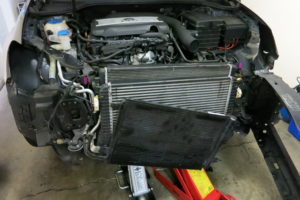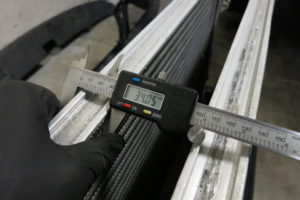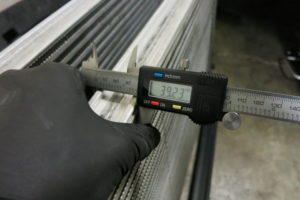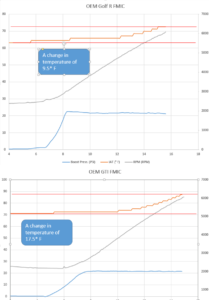I will preface this with the fact that the OEM front mount intercooler (FMIC) on the VW GTI is very good for an OEM unit. Here’s a little comparison between the MK6 GTI and the OEM unit on a MK3 Focus ST. 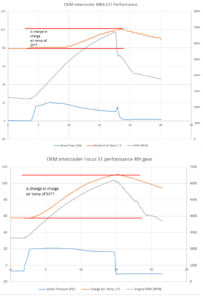 When you are looking at the performance of an intercooler you want to look at the difference in temperature between the beginning and end of a wide open throttle run. This change in temperature will tell you whether the FMIC is maintaining a cold air charge or whether it is struggling. The OEM Focus ST FMIC in this case is clearly struggling in comparison to the GTI and this comes down to the size. The GTI/Golf R FMIC is very large by comparison – having the same frontal area as the radiator!
When you are looking at the performance of an intercooler you want to look at the difference in temperature between the beginning and end of a wide open throttle run. This change in temperature will tell you whether the FMIC is maintaining a cold air charge or whether it is struggling. The OEM Focus ST FMIC in this case is clearly struggling in comparison to the GTI and this comes down to the size. The GTI/Golf R FMIC is very large by comparison – having the same frontal area as the radiator!
Our COBB Tuned development GTI received its final piece to being fully bolted with the F23T turbo. The Golf R FMIC. The install is quite straightforward. There are a lot of screws to take out of the front end to get to the FMIC (bumper and crash bar must come out) as it is between the AC condenser and radiator so if you DIY this install make sure you keep track of these. Having a second pair of hands and a couple of floor jacks to support the cooling stack as you take out and put in the FMIC helps.
I really do like the design of the cooling stack. Lots of airflow in the front end of this car. The R FMIC has a core that is 5mm thicker and it has 31 rows versus the GTI 27 rows.
Some data comparisons indicate that on a 4th gear pull the change in temperature from the beginning to the end has dropped from 17.5* F to 9.5* F with the R FMIC. A second advantage to the better flowing and larger R FMIC is a smaller pressure drop across its core. Due to the lower pressure drop and lower temperatures, at the same boost pressure the turbo is more efficient and we also gained around 4-5 g/s of airflow.
I do recommend this upgrade for stock and upgraded turbos alike. The GTI FMIC is quite good but the R FMIC is a direct fit, relatively inexpensive, and will be worth around 5-10whp and be more resilient during multiple pulls.


